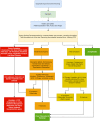A complete, evidence-based review on novichok poisoning based on epidemiological aspects and clinical management
- PMID: 36762227
- PMCID: PMC9905702
- DOI: 10.3389/ftox.2022.1004705
A complete, evidence-based review on novichok poisoning based on epidemiological aspects and clinical management
Abstract
Background: The whole world has learned about the existence of a highly toxic neuro-paralytic substance called Novichok. A wide range of neuro-paralytic toxins were used during the wars of decades ago, which also had harmful and irreversible effects. Fortunately, the establishment of conventions prohibiting the use of these weapons prevented the adverse clinical consequences of these compounds. What we did in the present study was to evaluate the clinical features of Novichok, how to manage exposure to it, and to evaluate the prognostic aspects associated with this poisoning agent. Methods: The manuscript especial databases including Medline, Web of knowledge, Google scholar, and Scopus were deeply searched by the two blinded investigators for all eligible studies based on the considered keywords. Initially 98 articles were initially collected by database searching that considering eligibility criteria, 83 articles were finally eligible for the final assessment. There is a lack of clinical trials and case-cohort studies on general population about treatment and side effects when it comes to human nerve agents and most of the data in our search is based on animal studies. Results: In evaluating various clinical, auto physiological and prognostic aspects of exposure to these substances, special attention was necessary to the following points. First, Novichok agents are considered more potent than other toxic agents. Pathophysiologically, these agents irreversibly bind acetylcholinesterase and produce a rapid cholinergic toxidrome which is responsible for the clinical manifestations as well as the potential dangerous and life threatening side effects caused by these agents. Uniquely, these agents are thought to also target every neuron in the central and peripheral nervous system. As a managerial and therapeutic approach, early and timely treatment of its related complication along with prevents massive exposure and decontamination in addition to rapid resuscitation can prohibit debilitating neuropathy and death due to facing it. Conclusion: The present review highlights the importance of recognizing the potential acute toxic effects of Novichok agents, diagnostic and therapeutic approaches (life-saving antidotal therapy) to complications and ultimately the application of guidelines to improve the prognosis of exposure to these agents for both victims and medical community.
Keywords: NOVICHOK; clinical manifestations; poisoning; prognosis; toxicity.
Copyright © 2023 Charejoo, Arabfard, Jafari and Nourian.
Conflict of interest statement
The authors declare that the research was conducted in the absence of any commercial or financial relationships that could be construed as a potential conflict of interest.
Figures
Similar articles
-
Novichok agents: a historical, current, and toxicological perspective.Toxicol Commun. 2018;2(1):45-48. doi: 10.1080/24734306.2018.1475151. Epub 2018 Jun 29. Toxicol Commun. 2018. PMID: 30003185 Free PMC article.
-
Current Perspectives on the Management of Patients Poisoned With Novichok: A Scoping Review.Mil Med. 2024 May 18;189(5-6):e1381-e1389. doi: 10.1093/milmed/usad464. Mil Med. 2024. PMID: 38035754
-
Effective skin decontamination with RSDL® (reactive skin decontamination lotion kit) following dermal exposure to a Novichok class nerve agent.Chem Biol Interact. 2024 May 25;395:111001. doi: 10.1016/j.cbi.2024.111001. Epub 2024 Apr 18. Chem Biol Interact. 2024. PMID: 38641146
-
Beyond the black stump: rapid reviews of health research issues affecting regional, rural and remote Australia.Med J Aust. 2020 Dec;213 Suppl 11:S3-S32.e1. doi: 10.5694/mja2.50881. Med J Aust. 2020. PMID: 33314144
-
Organophosphorus nerve agent poisoning: managing the poisoned patient.Br J Anaesth. 2019 Oct;123(4):457-463. doi: 10.1016/j.bja.2019.04.061. Epub 2019 Jun 24. Br J Anaesth. 2019. PMID: 31248646 Review.
References
-
- Bajgar J. (2012). Nerve agents poisoning and its treatment in schematic figures and tables. Amsterdam, Netherlands: Elsevier.
-
- Balali-Mood M., Mathews R., Pita R., Rice P., Romano J., Thiermann H., et al. (2016). Practical guide for medical management of chemical warfare casualties. International cooperation and assistance division, assistance and protection branch. The Hague, Netherlands: OPCW.
Publication types
LinkOut - more resources
Full Text Sources
Research Materials




